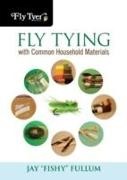Read more
In a friendly, humorous and non-technical way, offers directions and patterns for hand-made flies using off-the-shelf materials, saving money and creating better results. Zusammenfassung In a friendly! humorous and non-technical way! offers directions and patterns for hand-made flies using off-the-shelf materials! saving money and creating better results. Chapter 1: Adhesives How to use common adhesives in order to make your tying easier and the final product more durable. Chapter 2: Paints Using dabs of house paint or stripes from a permanent marker adds color to your flies, improving their fish-catching qualities. It also makes them look good in the fly box. Chapter 3: Grocery Bags Plastic bags from the corner store make for marvelous bodies on nymphs and spiders. Chapter 4: Packing Material Don't throw it away. This material can be used to create great bodies on dry flies. Chapter 5: Plastic Lacing Add flash, weight and establish a great silhouette on many of your favorite streamer patterns. Chapter 6: Eyes Doll eyes, stick-on, plastic and metal bead-chain and more. Eyes make your creations look more realistic. Chapter 7: Craft Store Beads Common craft store beads make for great bead head nymphs and even some unique nymph bodies. Chapter 8: Dubbing Learn how to make your own dubbing with natural and synthetic materials. Chapter 9: Wing Material A creative fly tier can make a lifetime supply of wing material for about ten dollars. Chapter 10: Wings and Posts Fibers from Mylar piping and seat belts cost little or nothing and work much better than the more pricey conventional materials. Chapter 11: Ribbons There are thousands of different kinds of ribbons, and they can be used for streamer bodies, wings, and wing pads. Chapter 12: Yarns The selection changes from week to week, offering the fly tier hundreds of unique possibilities. Chapter 13: Backer Rod and Rubber WeatherSeal One of my best finds in recent years. These insulation materials make great popper bodies for bass and panfish. Chapter 14: Balsa Wood Shape, sand, epoxy and paint this material, transforming a small piece of wood into beautiful popper heads. Chapter 15: Foam Blocks Here are the best types of foam to use, as well as instructions on how to slice it and shape it. Chapter 16: Sheet Foam Tie smaller panfish flies with a single layer, or combine layers to produce larger bass patterns. Chapter 17: Hooks Sometimes it's better to tie a fly on a hook made for bait fishing. Chapter 18: Great Legs Learn how to put the endless variety of leg material to good use. Chapter 19: Fingernails Possibly the strangest material I use, but the end result is a couple of very productive patterns. Chapter 20: Stretch Cord Found in the jewelry department of the craft stores, this material is used for over bodies and to reduce tippet failure. ...

